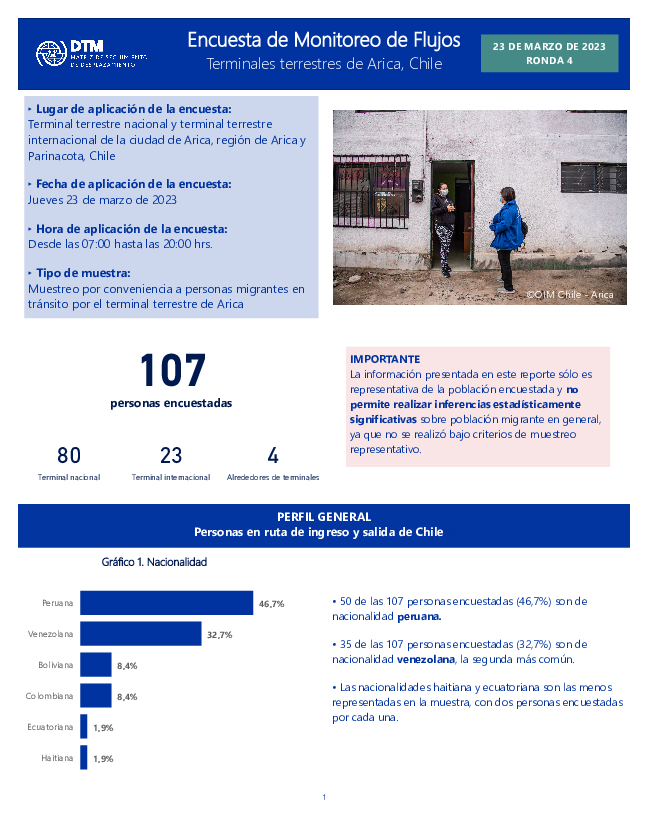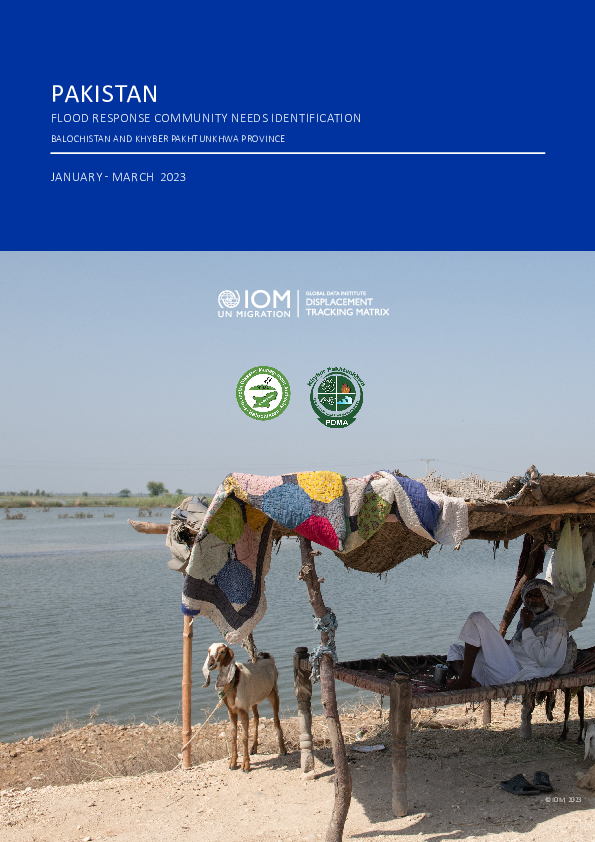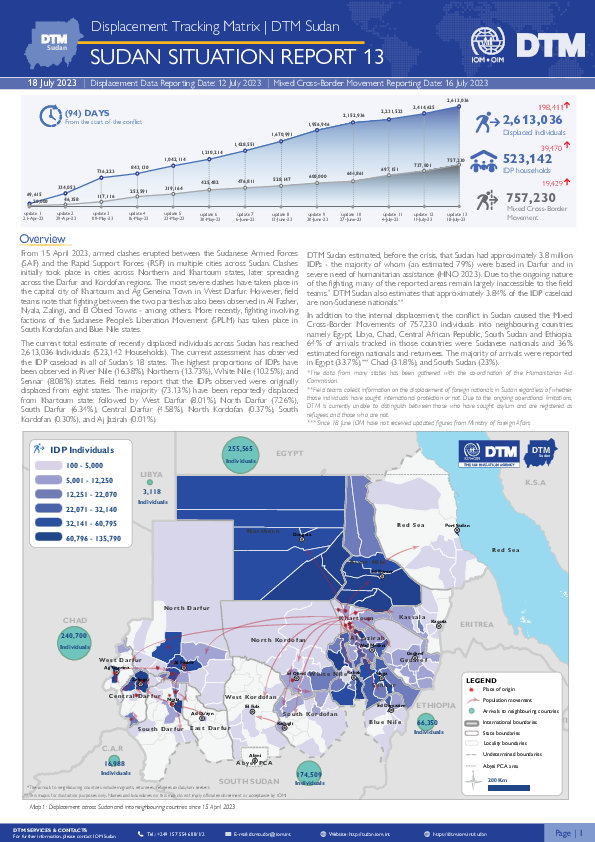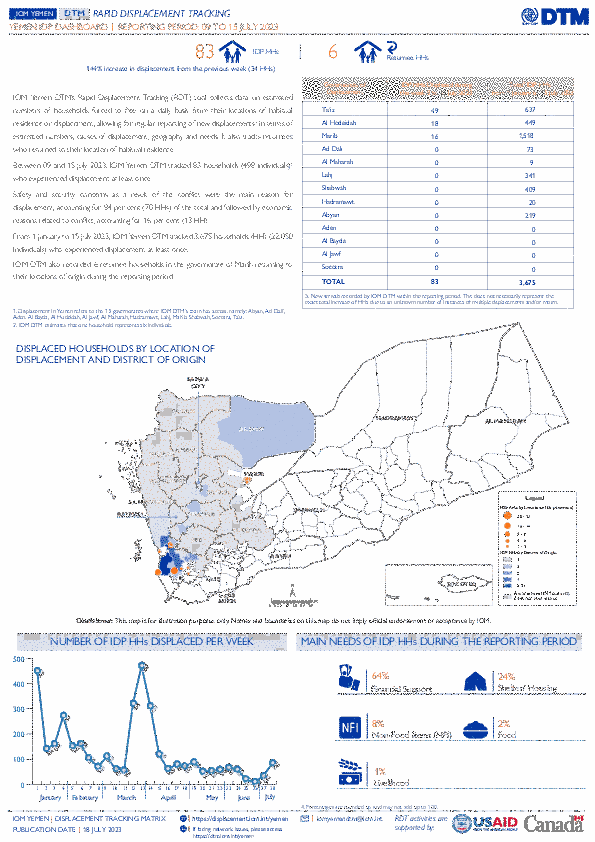-
Countries
-
Data and Analysis
-
Special Focus
-
Crisis Responses
Contact
DTM Sudan, DTMSudan@iom.int
Location
Sudan
Activity
- Mobility Tracking
- Baseline Assessment
Period Covered
May 19 2023 -Jul 16 2023
The current total estimate of recently displaced individuals across Sudan has reached 2,613,036 Individuals (523,142 Households). The current assessment has observed the IDP caseload in all of Sudan’s 18 states. The highest proportions of IDPs have been observed in River Nile (16.38%), Northern (13.73%), White Nile (10.25%), and Sennar (8.08%) states. Field teams report that the IDPs observed were originally displaced from eight states. The majority (73.13%) have been reportedly displaced from Khartoum state; followed by West Darfur (8.01%), North Darfur (7.26%), South Darfur (6.34%), Central Darfur (4.58%), North Kordofan (0.37%), South Kordofan (0.30%), and Aj Jazirah (0.01%).
Population Groups
Survey Methodology
Unit of Analysis Or Observation
Type of Survey or Assessment
Keywords
Geographical Scope
Administrative boundaries with available data
The current dataset covers the following administrative boundaries

Contact
iomdtmchile@iom.int
Language
English
Location
Chile
Period Covered
Mar 23 2023
Mar 23 2023
Activity
- Survey
Según las últimas estimaciones publicadas por el Instituto Nacional de Estadística (INE) y el Servicio Nacional de Migraciones (SERMIG), un aproximado de 444 mil personas venezolanas se encontraban en Chile hasta diciembre de 2021, lo que mantiene a Chile como uno de los países con mayor cantidad de población venezolana en el mundo.
En ese sentido, la OIM Chile, como parte de su estrategia de producción de información al servicio los y las tomadores de decisión, ha implementado la DTM Encuestas de Monitoreo de Flujos en la región de Arica y Parinacota con el objetivo de identificar el perfil de las personas que ingresan por esta frontera, caracterizar sus experiencias en ruta, consultar respecto a la documentación con la que viajan y conocer sus intenciones futuras.

Contact
dtmpakistan@iom.int
Language
English
Location
Pakistan
Period Covered
Jan 06 2023
Mar 28 2023
Activity
- Survey
- Mobility Tracking
- Site Assessment
From June to October 2022, storms and heavy monsoon rains in Pakistan have caused widespread flooding and landslides across the country. According to the National Disaster Management Authority (NDMA), up to 33 million people have been affected by the floods and a total of 90 districts have been labelled by the Government of Pakistan as ‘calamity-hit’, as of 18 November 2022. Given the number of calamity-hit districts and the number of affected people, IOM's Displacement Tracking Matrix (DTM) decided to roll out its Community Needs Identification (CNI) assessment. This was done following coordination and approval from the Provincial Disaster Management Authority (PDMA) of Balochistan and Khyber Pakhtunkhwa. Following the first round of the CNI, IOM implemented a second round of the CNI between January and March 2023 to provide partners with timely information on the displacement situation and multisectoral needs of the affected population at the village level.2 For the second round, IOM expanded its CNI from 13 to 19 districts in the provinces of Balochistan and Khyber Pakhtunkhwa. The CNI was conducted in a total of 6,367 flood affected villages or villages that hosted temporary displaced persons (TDPs) across the 19 targeted districts.

Contact
DTM Sudan; dtmsudan@iom.int
Language
English
Location
Sudan
Period Covered
Jul 12 2023
Jul 12 2023
Activity
- Mobility Tracking
- Baseline Assessment
From 15 April 2023, armed clashes erupted between the Sudanese Armed Forces (SAF) and the Rapid Support Forces (RSF) in multiple cities across Sudan, including Khartoum, Al Fasher, Kebkabiya, Merowe, Nyala, Zalingi, Ag Geneina, and El Obeid. DTM Sudan has been receiving reports of widespread displacement across different states in Sudan due to the ongoing security situation.
- DTM Sudan estimates that, since 15 April 2023, approximately 2,613,036 individuals (523,142 households) have been displaced internally as a result of the conflict. Notably, the current estimate for displacement in the previous 94 days is greater than that of recorded displacement during the previous four years.
- Furthermore, an estimated additional 757,230 individuals have crossed into neighbouring countries.
Due to the ongoing nature of the fighting, many areas reportedly remain inaccessible to field teams. DTM estimates of displacement are based on preliminary reports from field teams and should be taken as estimations only. Additional reports of displacement are likely to emerge as the situation becomes clearer.
The IDP caseload has sought shelter in locations across all of Sudan’s 18 states. IDPs have been originally displaced from eight states, including Khartoum, West Darfur, South Darfur, North Darfur, Central Darfur, North Kordofan, South Kordofan, and Aj Jazirah.
Disclaimer: DTM Sudan notes that military clashes remain continuous in many areas across Sudan in particular in Khartoum and the Darfur region – limiting humanitarian access. Additionally, field teams have reported severe telecommunication and connectivity issues, as well as escalating economic pressures which have impacted the capacity for domestic travel. As such, DTM is currently conducting remote interviews with key informants across its network and is currently unable to engage in the additional verification of these figures. Data on flows into neighbouring countries is based on available information from DTM flow monitoring networks and secondary sources.

Contact
DTM Nigeria, iomnigeriadtm@iom.int
Language
English
Location
Nigeria
Period Covered
Jun 01 2023
Jun 30 2023
Activity
- Mobility Tracking
- Event Tracking
To better understand trends in transhumance movements, assess the impact of conflicts, mitigate transhumant herders and sedentary farmers’ conflicts in Adamawa and Taraba states in Nigeria, the transhumance tracking tools, as a component of the IOM's Displacement Tracking Matrix (DTM) and supported by a network of community key informants, operationalised the Early Warning System in 5 Local Government Areas (LGAs) of Adamawa state out of the selected 9 LGAs in 2 states (7 and 2 LGAs of Adamawa and Taraba state respectively) triangulated 219 alerts were across the 5-project operationalised LGAs in Adamawa state.
The triangulated alerts comprise 172 (79%) events and 47 (21%) movement alerts. The largest number of reported alerts is in Demsa LGA (32%) followed by Lamurde LGA (25%), Numan LGA (20%), Girei (12%), and Mayo-Belwa LGA (11%). The disaggregated alerts show the highest reported event alerts of 9 per cent each in the Gereng and Kodompti wards of Girei and Numan LGA respectively followed by Ndikong (7%) while 5 per cent alerts were reported for each ward of Bille in Demsa LGA, Waduku, Dubange, Gyawana, Lafiya, Lamurde wards in Lamurde LGA and Bwalki ward in Numan LGA.
The alerts resulted to population displacement in 1 per cent of instances, while 23 per cent result in casualties or injuries.
Contact
DTM Haiti, DTMHaiti@iom.int
Location
Haiti
Activity
- Mobility Tracking
- Baseline Assessment
Period Covered
Jun 12 2023 -Jul 03 2023
A baseline assessment is a sub-component of mobility tracking. It aims to collect data on IDP, migrant or returnee population presence in a defined administrative area of the country.
Population Groups
Survey Methodology
Unit of Analysis Or Observation
Type of Survey or Assessment
Keywords
Geographical Scope
Administrative boundaries with available data
The current dataset covers the following administrative boundaries

Contact
DTM Pakistan, iomisbdtmremapteam@iom.int
Language
English
Location
Pakistan
Period Covered
Apr 01 2023
Jun 30 2023
Activity
- Flow Monitoring
IOM Pakistan collects data on the outflows of undocumented Afghan nationals at the Torkham and Chaman border crossing points in an effort to better understand the migration movements of undocumented Afghan nationals returning to Afghanistan from Pakistan. Key findings during this reporting period are:
• Between April and June 2023, 24,822 undocumented Afghan nationals spontaneously returned to Afghanistan, including 11,397 through the Torkham border point and 13,425 through the Chaman border point. Border authorities facilitated the return of 1,229 individuals due to the lack of legal documentation to remain in Pakistan. Therefore, information concerning these 1,229 individuals is not included in the count.
• Although IOM identified 24,822 undocumented Afghan returnees at two border crossings, this may not reflect the total number of undocumented Afghan returnees. Moreover, for this study, only the head of household or representative of the family were interviewed. This means that the number of interviews conducted by the enumerators is lower than the number of returnees recorded by IOM. Between April and June 2023, IOM interviewed 1,134 respondents.
• The average family size of returnees was six individuals and five per cent of all returnees recorded during the reporting period were categorized as vulnerable persons.
• The top three challenges returnees expected to face in Afghanistan were: arranging livelihoods, settling into a new city and finding better income opportunities.
• All returnees were carrying household items when surveyed. They also travelled with additional items, such as personal belongings (99%), cash (97%), productive assets (88%), transportation vehicles (3%) and livestock (1%).
Contact
DTM Yemen, iomyemendtm@iom.int
Location
Yemen
Activity
- Mobility Tracking
- Event Tracking
Period Covered
Jul 09 2023 -Jul 15 2023
From 1 January to 15 July 2023, IOM Yemen DTM tracked 3,675 households (HH) (22,050 Individuals) who experienced displacement at least once.
Between 9 and 15 July 2023, IOM Yemen DTM tracked 83 households (498 individuals) displaced at least once. The majority of people moved into/within the following governorates and districts:
- Ta’iz (49 HHs) – Mawza (35 HHs), Al Makha (10 HHs), Al Maafer (3 HHs) districts. Most displacements in the governorate were internal.
- Al Hodeidah (18 HHs) – Hays (15 HHs), Al Khukhah (3 HHs) districts. Most displacements in the governorate were internal.
- Ma’rib (16 HHs) – Ma’rib City (9 HHs), Ma’rib (7 HHs) districts. Most displacements in the governorate originated from Al Hodeidah and Sanaa.
- Ta’iz (45 HHs) – Al Makha (35 HHs), Maqbanah (4 HHs), At Ta’iziyah (3 HHs) districts.
- Al Hodeidah (24 HHs) – Hays (12 HHs), Al Jarrahi (4 HHs), Jabal Ras (2 HHs) districts.
- Dhamar (5 HHs) – Wusab Al Aali (2 HHs), Dawran Anis (2 HHs), Otmah (1 HHs) districts.
Population Groups
Survey Methodology
Unit of Analysis Or Observation
Type of Survey or Assessment
Keywords
Geographical Scope
Administrative boundaries with available data
The current dataset covers the following administrative boundaries

Contact
DTM Yemen, iomyemendtm@iom.int
Language
English
Location
Yemen
Period Covered
Jul 09 2023
Jul 15 2023
Activity
- Rapid Emergency Registration
- Mobility Tracking
IOM Yemen DTM’s Rapid Displacement Tracking (RDT) tool collects data on estimated numbers of households forced to flee on a daily basis from their locations of origin or displacement, allowing for regular reporting of new displacements in terms of estimated numbers, geography, and needs. It also tracks returnees who returned to their location of origin.
From 1 January to 15 July 2023, IOM Yemen DTM tracked 3,675 households (HH) (22,050 Individuals) who experienced displacement at least once.
Between 9 and 15 July 2023, IOM Yemen DTM tracked 83 households (498 individuals) displaced at least once. The majority of people moved into/within the following governorates and districts:
- Ta’iz (49 HHs) – Mawza (35 HHs), Al Makha (10 HHs), Al Maafer (3 HHs) districts. Most displacements in the governorate were internal.
- Al Hodeidah (18 HHs) – Hays (15 HHs), Al Khukhah (3 HHs) districts. Most displacements in the governorate were internal.
- Ma’rib (16 HHs) – Ma’rib City (9 HHs), Ma’rib (7 HHs) districts. Most displacements in the governorate originated from Al Hodeidah and Sanaa.
The majority of people moved from the following governorates and districts:
- Ta’iz (45 HHs) – Al Makha (35 HHs), Maqbanah (4 HHs), At Ta’iziyah (3 HHs) districts.
- Al Hodeidah (24 HHs) – Hays (12 HHs), Al Jarrahi (4 HHs), Jabal Ras (2 HHs) districts.
- Dhamar (5 HHs) – Wusab Al Aali (2 HHs), Dawran Anis (2 HHs), Otmah (1 HHs) districts.
The Central African Republic (CAR), which has experienced continuous volatility for the past two decades, has been riddled by a crisis which ignited in 2012 with a violent takeover of power and has developed into a complex protracted state of permanent insecurity and fragility which has spilled over into neighbouring countries. The crisis is characterized by power struggles amongst elites, the absence of state institutions and public investment, religious and ethnic tensions and disputes for the control of key resources. More recently, the crisis in Sudan, which started in April 2023, is affecting the eastern part of the CAR witnessing arrivals of displaced populations. As of June 2023, 3,819,924 individuals were affected, including 474,822 internally displaced persons (13% of the displaced population), 2,063,885 returnees former IDPs (54%), 503,019 returnees from abroad (13%) and 778,198 refugees (20%). In the CAR, the largest displaced population consists of former IDP returnees. Refugees from the CAR are primarily hosted by Cameroon (350,428 individuals, or 45% of the refugees), the Democratic Republic of the Congo (DRC) (210,238 individuals, or 27% of the refugees) and Chad (127,934 individuals, or 16% of the refugees).
